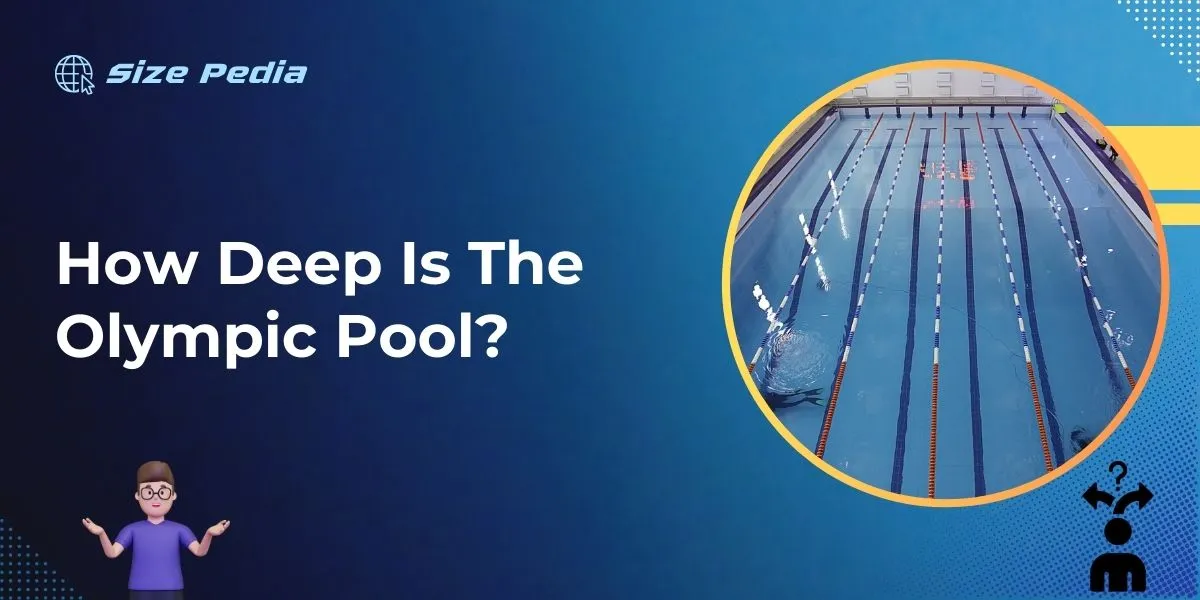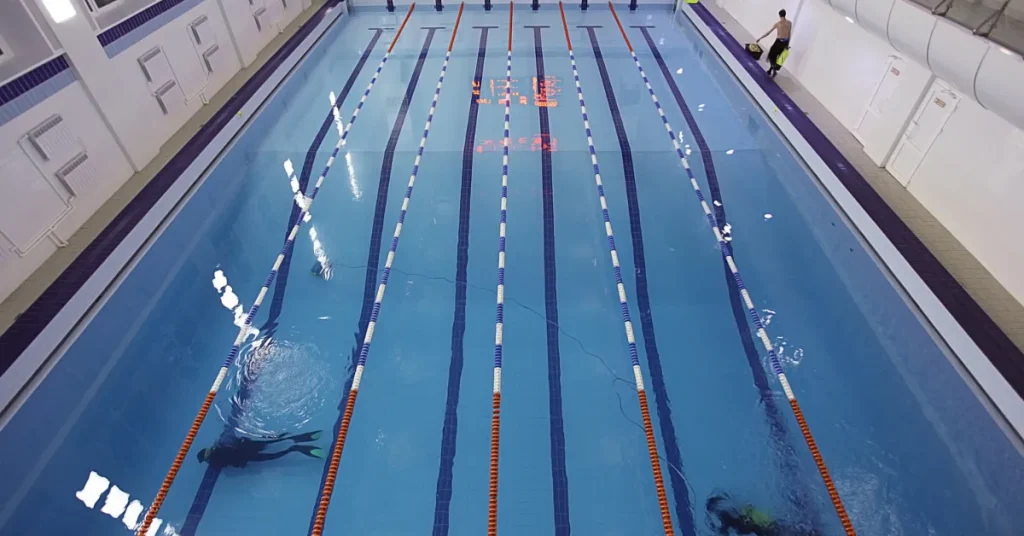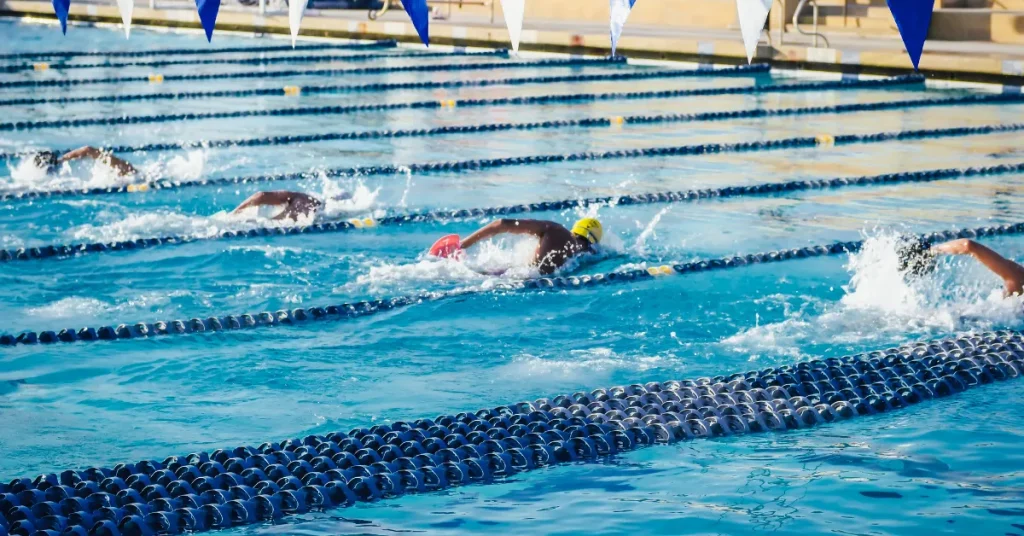An Olympic swimming pool is 2 meters deep, or approximately 6.6 feet. It is a standardized dimension for this high-level competition.
Swimming enthusiasts and athletes around the world recognize the Olympic pool as a symbol of peak athletic performance.
The size of the pool not only meets international competition standards but also ensures the safety and speed of swimmers. This depth helps to reduce waves, enabling swimmers to achieve their best times.
The consistency across all Olympic pools allows for accurate comparative records. These facilities are designed for various events, including freestyle, backstroke, breaststroke, butterfly, and individual medleys.
The Olympic pool’s depth is but one aspect of its design, which follows strict regulations to ensure fairness and excellence in the world of competitive swimming.

Plunging Into Specifications
Plunge Into Specifications: Curiosity floats as minds dive into the intricacies of an Olympic pool. Grasping the depth of where champions glide, reveals the vastness of this aquatic stage. Let’s unravel these measures together!
Dimensions And Volume
An Olympic pool is a marvel in design, crafted for world-class competition. The standard depth runs at 2 meters, or about 6.5 feet. This depth keeps the water from being too turbulent, giving athletes the steadiness they need for optimal performance.
| Dimension | Measurement |
| Length | 50 meters (164 feet) |
| Width | 25 meters (82 feet) |
| Depth | 2 meters (6.5 feet) |
Olympic pools hold a staggering 2,500,000 liters or 660,430 gallons of water!
Comparisons To Common Pools
An average backyard swimming pool pales in comparison to the might of an Olympic giant. Here’s how they stack up:
- A typical home pool: 1.5 meters deep and holds around 75,708 liters (20,000 gallons).
- Above-ground pools often hover at 1.2 meters deep.
- Community pools vary but are commonly 1.0 – 1.4 meters deep.
Olympic pools dwarf standard sizes, providing the expanse necessary for high-caliber competition.
Regulations For Competitive Swimming

The thrill of competitive swimming hinges not just on the prowess of athletes but also on the precise regulations that govern their aquatic battlefield: the Olympic pool.
These rules ensure fairness and optimal conditions for record-breaking performances. Let’s dive into the specifics that make these pools a cornerstone of world swimming competitions.
Fina Standards
FINA, the International Swimming Federation, sets stringent standards for Olympic pools. These standards are:
- Length: The pool must be 50 meters long.
- Width: It should have a minimum width of 25 meters.
- Lanes: There must be at least 8 lanes, each 2.5 meters wide.
- Depth: The minimum depth is 2 meters, providing safety for turns and starts.
This design enables swimmers to perform at their best without hindrances.
Temperature And Water Quality Control
The temperature and quality of pool water significantly impact athletic performance. Regulations state:
- Water temperature must be between 25°C to 28°C.
- Pools require a high-quality filtration system to maintain clarity and hygiene.
- Regular checks ensure balance in water chemicals like chlorine.
These conditions foster a comfortable and safe environment for competitors.
Architectural Marvels
The grandeur of Olympic swimming pools extends beyond their function. These monumental structures are a blend of precision, innovation, and style.
They embody the spirit of the competition and the pinnacle of human athletic achievement. Architects and engineers collaborate to create these pools, ensuring each one is a marvel of modern design.
Innovative Design Techniques
Olympic pools stand out with their cutting-edge designs. They must meet strict regulations while offering swimmers the best conditions.
Innovative techniques come into play, from advanced water filtration to the minimization of waves. Below are key elements that make these pools world-class:
- Depth: An Olympic pool is 3 meters deep. This depth prevents waves from bouncing off the bottom, creating optimal conditions for speed.
- Overflow Gutters: Special gutters absorb waves, keeping the water calm and swimmers focused.
- Temperature Control: Systems ensure a consistent temperature between 25 to 28 degrees Celsius, ideal for peak performance.
Iconic Olympic Pools
Olympic history is rich with iconic pools, each telling its own story of triumph and architectural brilliance. Here’s a snapshot of some remarkable pools:
| Pool | Location | Year |
| Aquatics Centre | London, UK | 2012 |
| Water Cube | Beijing, China | 2008 |
| Olympic Indoor | Athens, Greece | 2004 |
These pools are not just for sports. They stand as landmarks in their cities, showcasing the innovation of modern architecture and the enduring legacy of the Olympic Games.
Influence On Athlete Performance

The performance of Olympic swimmers is a marvel to behold. The depths of the pools where these athletes compete play a crucial role.
A suitably deep pool can reduce the interference from waves, allowing swimmers to perform at their best. Now, let’s dive into how this profound depth impacts their performances and explore the strides made in pool design.
The Impact Of Depth
When it comes to competitive swimming, every detail matters. The depth of an Olympic pool is no exception. Standard Olympic pools are 2 meters deep, a measurement that is not arbitrary.
This depth is essential for minimizing the creation of waves. Waves can slow swimmers down and make races less fair. With deeper pools, water movement from kicks and strokes heads downwards, away from competitors.
This ensures that all lane conditions are as equal as possible. Athletes can focus on speed without the worry of waves hampering their performance.
Technological Advancements
Over the years, technological advancements have enhanced Olympic pool designs. Engineers have created specialized systems for water circulation and filtration. Such systems maintain optimal conditions.
The walls and floors of these pools also have thoughtful designs. Designers make them to absorb rather than reflect waves.
This combination of depth and technology provides an ideal environment. Swimmers perform at the peak of their abilities. It creates a stage where world records can, and often do, fall.
Beyond The Lap Lanes
Exploring the depths of an Olympic pool is an adventure that goes well beyond the lap lanes. While these aquatic arenas are designed for elite athletes to compete, their legacy stretches far past the closing ceremonies.
Multifunctional Use Post-olympics
Olympic pools boast a life that extends well beyond the splash of the games.
- Community swimming lessons – locals learn to swim.
- Recreational swimming – a fun destination for families.
- Water polo and synchronized swimming events – the excitement continues.
- Hosting national and international swimming competitions – a legacy lives on.
Environmental Considerations
An Olympic pool’s design now embraces sustainability.
- Water recycling systems save and clean water.
- Energy-efficient heating keeps the pool warm.
- Solar panels can power the facility.
- Use of green building materials reduces impact.
- Advanced filtration uses fewer chemicals.
FAQs About How Deep Is The olympic pool
What Is The Standard Depth Of An Olympic Pool?
The standard depth of an Olympic swimming pool is at least 2 meters (about 6. 5 feet). This depth is essential to reduce the waves produced by swimmers, allowing for faster times and a more controlled swimming environment.
How Does Pool Depth Affect Swimmer Performance?
Increased pool depth can significantly reduce water turbulence, which in turn minimizes resistance against swimmers. This contributes to improved performance and faster swim times, as athletes can maintain better speed throughout their races.
Are All Olympic Pools The Same Size?
All Olympic pools must measure 50 meters in length and 25 meters in width to qualify for competitions. However, depth can vary slightly but must be a minimum of 2 meters to maintain consistency and performance standards for Olympic events.
What Is The Minimum Water Depth For Diving Events?
For Olympic diving events, the pool depth must be at least 3 meters (about 9. 8 feet). This ensures the safety of divers when they enter the water from various heights, which can reach up to 10 meters for platform events.
Conclusion
Diving into the depths of Olympic pools, we’ve uncovered fascinating details. Standardized at 3 meters deep, they ensure athletes’ performance and safety. These aquatic arenas are marvels, blending engineering with competitive spirit.
Remember, whether for sport or leisure, every pool holds a world of discovery beneath its tranquil surface.
Dive in!
Resources:
1. https://www.kerrvilletx.gov/802/Olympic-Pool
